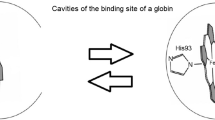Abstract.
In order to get more reliable electronic structure of protein in aqueous solution, it is necessary to construct a simple, easy-use equivalent potential of water molecules for protein's electronic structure calculation. The first-principles, all-electron, ab initio calculations have been performed to construct the equivalent potential of water molecules for the electronic structure of Cys. The process consists of three steps. First, the electronic structure of the cluster containing Cys and water molecules is calculated. Then, based on the structure, the electronic structure of Cys with the potential of water molecules is calculated using the self-consistent cluster-embedding method. Finally, the electronic structure of Cys with the potential of dipoles is calculated. The dipoles are adjusted so the electronic structure of Cys with the potential of dipoles is close to that of water molecules. The calculations show that the major effect of water molecules on Cys' electronic structure is lowering the occupied electronic states by about 0.032 Ry, and broadening energy gap by 16%. The effect of water molecules on the electronic structure of Cys can be simulated by dipoles potential.
Similar content being viewed by others
References
Haoping Zheng, Phys. Lett. A 226, 223 (1997); 231, 453 (1997)
Haoping Zheng, Phys. Rev. B 48, 14868 (1993)
Haoping Zheng, Physica B 212, 125 (1995)
H. Zheng, B.K. Rao, S.N. Khanna, P. Jena, Phys. Rev. B 55, 4174 (1997)
H. Zheng, Y. Wang, G. Ma, Eur. Phys. J. B 29, 61 (2002)
J. He, H. Zheng, Acta Phys. Sin. (in Chinese) 51, 2580 (2002)
Shaojie Lin, Haoping Zheng, Acta Phys. Sin. (in Chinese) 54, 4680 (2005)
Haoping Zheng, Shaojie Lin, J. Phys. Conf. Ser. 29, 129 (2006)
Haoping Zheng, Phys. Rev. E 62, 5500 (2000)
Haoping Zheng, Progress in Physics (in Chinese) 20, 291 (2000)
Haoping Zheng, Modern Phys. Lett. B 16, 1151 (2002)
Haoping Zheng, Phys. Rev. E 68, 051908 (2003)
Themis Lazaridis, Martin Karplus Proteins: Structure, Function, and Genetics 35, 133 (1999)
Themis Lazaridis, Martin Karplus, J. Mol. Boil. 288, 477 (1998)
L. Onsager, J. Am. Chem. Soc. 58, 1486 (1936)
A. Klamt, G. Schuurmann, J. Chem. Soc. Perkin. Trans. 2, 799 (1993)
Hong Guo, Martin Karplus, J. Phys. Chem. 98, 7104 (1994)
Michael Schaefer, Martin Karplus, J. Phys. Chem. 100, 1578 (1996)
F. Eckert, A. Klamt, AIChE J. 48, 369 (2002)
J.B. Foresman, T.A. Keith, K.B. Wiberg, J. Snoonian, M.J. Frisch, J. Phys. Chem. 100, 16098 (1996)
P. Hohenberg, W.J. Kohn, Phys. Rev. B 136, 864 (1964)
W. Kohn, L.J. Sham, Phys. Rev. A 140, 1133 (1965)
H. Chen, Ph.D. thesis, Department of Physics and Astronomy, Louisiana State University 1988 (unpublished)
H. Chen, J. Callaway et al., Phys. Rev. B 38, 195 (1988)
H. Chen, J. Callaway et al., Phys. Rev. B 44, 2289 (1991)
H. Zheng, Ph.D. thesis, Department of Physics and Astronomy, Louisiana State University 1993 (unpublished)
Haoping Zheng, Jun He, J. Tongji Univ. (in Chinese) 29, 593 (2001)
Wanhong Xu, Haoping Zheng, J. Tongji Univ. (in Chinese) 31, 374 (2003)
Shaojie Lin, Haoping Zheng, J. Tongji Univ. (in Chinese) 32, 551 (2004)
Jingan Hao, Haoping Zheng, Acta Phys. Sin. (in Chinese) 53, 1044 (2004)
Haoping Zheng, Jingan Hao, Chinese Physics 14, 529 (2005)
Author information
Authors and Affiliations
Corresponding author
Rights and permissions
About this article
Cite this article
Wang, XM., Zheng, HP. & Li, CJ. The equivalent potential of water molecules for electronic structure of cysteine. Eur. Phys. J. B 52, 255–263 (2006). https://doi.org/10.1140/epjb/e2006-00284-8
Received:
Published:
Issue Date:
DOI: https://doi.org/10.1140/epjb/e2006-00284-8




